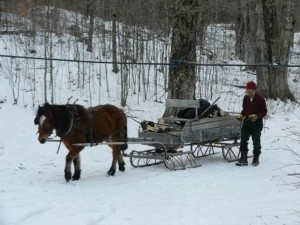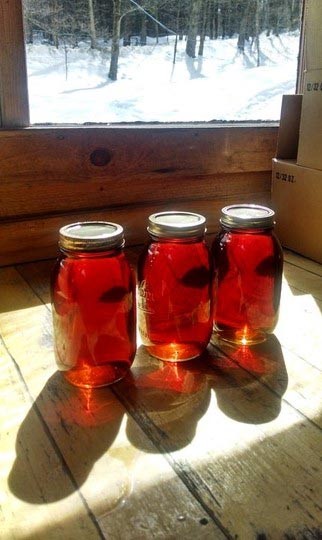Art Krueger and his wife Trish Norton have been making and selling maple syrup from their Krueger-Norton Sugarhouse in Shrewsbury, Vermont, for more than three decades. By Vermont standards, their sugaring operation is a small one – about 2,400 taps. While many sugarmakers now rely on oil-fired evaporators, everything here is still wood-fired. They live off the grid, finding much of what they need in the woods surrounding the home they built. Their horse, Teddy, helps haul firewood and logs.
I spent all my time in the woods as a kid. We lived in a suburban development, which was on the edge of a pretty big piece of woods. I used to have my little axe, and I always had these building projects that I thought I needed to do. The idea of cutting down poles and building a log cabin when you’re about 13 – you think you can do it, but you don’t get too far. I liked to make a bow and arrow out of a piece of hickory. I used to cut down things and chop them up and try to make things out of them. So, I haven’t changed.
I grew up in Waterbury, Connecticut, so I’m an immigrant to Vermont. I’m a refugee. They let me across the southern border. In 1969 I was a graduate student at the University of Rhode Island, in ocean engineering, of all things. I was interested in environmental things, and Vermont seemed to be the most ahead place. It was just really beautiful and wild and green. I got a job with the state of Vermont in the water resources department, and I lasted two years. I did move to New Hampshire for two years and then I came back.
When I came back from New Hampshire in the mid-70s, the land I bought had some maple on it. A neighbor came up and wanted to tap the trees. He tapped them the first year, and I tapped them thereafter and sold sap to him for a couple of years. I kept running that bush in Weston until five or six years ago, when my stepson son took over. It was good learning.
I moved to Shrewsbury and met my wife. She had a piece of land that happened to have maple trees on it, and I said – well, we should tap them. We built a house here and raised a family. We sold sap for the first couple of years. Then we decided to make the big bucks, and we borrowed some money to buy an evaporator, and we built a sugarhouse in ’89. That was the only debt we took out on the place. It’s long since paid off. We own eleven and a half acres. And we lease a bunch more, so we’re sugaring on about 40 acres.
I just started sugaring by doing it, learning, trying to pay attention. We get a lot of our living from the forest. All the heat for the house, all the fuel for the sugarhouse, all the wood to build the house and other structures. It’s a very important part of our economy.
We’ve thought about modernizing, but never thought about using oil to make syrup. It doesn’t make any sense to me, because it doesn’t really fit in with what we’re doing. To burn oil and not thin my woods just doesn’t make sense. We thought about reverse osmosis – or, at least I thought about it, my wife didn’t think much of it! What we do in our operation is we process it in the evaporator. When we’re done, we can the syrup into glass jars. We use the steam from the evaporator to can it, and we end up with a finished product in a container. If we went to reverse osmosis, it would speed up production to where we couldn’t do this. We would have to buy a canner, buy many 30-gallon stainless steel drums, and spend lots of time reheating and canning syrup in the off season.
Thirty-five years ago you couldn’t make your living in maple syrup, but we have people now who do it full time. The economies of scale have changed. I have two young neighbors who are running 40,000-plus taps. I’m running 2,400 maybe. They’re on a completely different scale than me. It’s like they’re on a different planet.
It’s a very different industry now. I don’t have reverse osmosis, but it’s really changed the industry considerably. Back in the ’70s we were using tubing but no vacuum. We know a lot more now than we did then. When I look back at what we were doing, it was pretty crude. The industry standards were pretty crude.
Teddy has been in the picture for six or seven years. I think he was 12 when I got him. He’s getting old, but I think I’ll get another 5 years out of him. And at 76, I think I’ll get another five years out of me. So we’re on the same rotation. I figure I can keep this up until I’m 80. Teddy is much stronger than I am. I’ve had horses for almost 50 years, and he’s the best one I’ve ever had.
Small horses are very good at carrying very heavy loads over rough ground for short distances. We can carry a third of a cord at a time on a cart. You can’t really do much damage to the woods with a little horse. You don’t have compaction and all those things you have with the heavy equipment. And I get along much better with the horse than I would get along with something bigger anyway. The land is pretty hummocky here. I suspect if I tried to use a tractor with it, I would have turned the tractor over on me by this time. With a horse, you’re standing beside the cart mostly, so you’re not in any particular danger. So it’s safe, and it has worked well for us.
Occasionally we make candy to sell, and some of it isn’t saleable for one reason or another. But Teddy is not very particular. He loves maple sugar.
We’re starting tapping trees now, and we’re gonna go hopefully into April. But we don’t know. We’re starting earlier than we used to. Traditionally, we’d start tapping on Town Meeting day. We wouldn’t tap in February. This year, it wouldn’t have been a terrible idea for us to tap in the middle of January. My neighbors tapped a portion of their bush in back in November, and they’ve been sugaring all winter. Maple sap will run any warm day after the leaves are off the trees. Earlier on you get a low sugar sap. With reverse osmosis, you can use the low sugar sap. So it’s not just a function of climate, it’s a function of technology.
The woods have changed, too. When I was a kid, we were seeing the last chestnuts in Connecticut. When I first got to Vermont, I spent a lot of time cutting elm up for firewood. Now it’s the ash. What’s next? It’s bothersome.
We live in a place where trees just like to grow. We never have to plant them. The resilience of the forest – this was all cut at one point. We’re sugaring on what was mostly cut-over pasture. There’s stone walls in the woods, and I’ll tell you, no farmer ever built a stonewall in the woods. And now there’s a healthy forest that has returned. That’s good.
The future of the forest depends on us. It depends on how we value it. One of the most interesting things is the capacity for sequestration of carbon and how we understand it. We need to educate people about not having a tree-hugging mindset. Trees don’t live forever. So you really want to keep land in forest, and you want to keep land so it’s a working landscape that’s used and valued. If it has value to us, then we’ll take care of it, and part of value is the economic value.







Discussion *